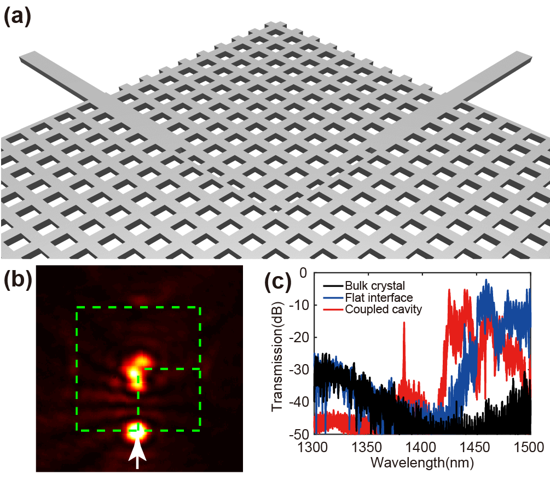Optical cavity, as one of the important elements of nanophotonics, is widely used in many fields, such as optical communications, sensing, quantum optics, and gravitational-wave detection. These applications have driven the development of high-performance cavity and cavity-based integrated devices, which is highly relevant to the control capability of cavity modes.
To manipulate cavity modes in photonic integrated circuits (PICs), many researches have focused on photonic crystal (PC) slab, through finely engineering point defects in a precise location of the PC slab. Such local method enables us to flexibly control the cavity modes in an extrinsic way, however, along with increasing the design complexity.
In recent years, the emerging field of topological photonics has opened up a new way to achieve intrinsic cavity mode with global method, i.e. cavity mode will be induced by the global feature of topological bulk states. Such intrinsic cavity mode is totally predictable by investigating the bulk topology, regardless of the local region of PC slab.
To design optical cavity in topological nanophotonics, a representative method is the second-order topological phase that a 2D PC with 2D insulating bulk states supports 0D topological corner states. Such 0D corner states with in-plane localization will induce small-mode-volume cavity mode, and thus the cavity size can be reduced for miniaturization.
However, for photonic crystal slab, it is previously lack of an intuitive understanding on such second-order topological phase and the in-plane excitation of corner states in experiment. For silicon PICs, it is crucial to experimentally couple the corner state by the propagating waves along waveguides (i.e. in-plane excitation), and thus can be straightforwardly compatible with other integrated devices.
The research team led by Prof. Jian-Wen Dong from Sun Yat-sen University researched a cross-coupled PC cavity based on second-order topology and observed topological corner state under in-plane excitation at telecommunication wavelength. The research results are published in Photonics Research, Volume 9, No. 8, 2021 (Xin-Tao He, Meng-Yu Li, Hao-Yang Qiu, et al. In-plane excitation of a topological nanophotonic corner state at telecom wavelengths in a cross-coupled cavity[J]. Photonics Research, 2021, 9(8): 08001423).
The device is patterned on 220-nm-thickness silicon wafer (SOI), and the SiO2 layer below PC region has been removed to enhance vertical light confinement. The SOI platform can be not only compatible with modern semiconductor nanofabrication process, but also allow integration with other optoelectronic devices in a silicon PIC.
The cavity device is formed by a 90-deg-bend interface, which consists of two types of dielectric-vein PCs, as shown in Fig. 1 (a). Each PC has different second-order topological phase, by evaluating the expectation values of mirror-flip operation of the PC Bloch modes in theory.
Due to the topologically-distinct feature, a localized mode is induced at the corner point of interface, i.e. topological corner state. In simulation, this mode is resonant at wavelength λ = 1400.515 nm with Q factor about 9000 and mode volume Vm = 0.366(λ/nsi)3.
Based on the design shown in Fig. 1(a), a cross-coupled PC cavity is fabricated to implement in-plane excitation of corner states. Experimental results show that the corner state is directly imaged near 1383 nm by far-field microscope [Fig. 1(b)]. Furthermore, by means of temporal coupled-mode theory, the intrinsic Q factor of cross-coupled cavity (about 8000) is retrieved from the measured transmission spectra [Fig. 1(c)].
This work is not simply an emulation of optical analogues of second-order topological phase in silicon photonics. Compared with previously related works on PC slab, this work uniquely develops a global quantity, i.e. the expectation values of mirror-flip operation of the PC Bloch modes, to quantitatively determine the topological phase, and designs a cross-coupled cavity to achieve the in-plane excitation of topological corner states.
Future works will focus on applying topological corner state for the practical implement of cavity-mode-based passive devices (e.g. optical filters, routers, wavelength-division multiplexers in silicon PICs), and the implement of topological photonic chips for optical information transfer.

Fig.1 Cross-coupled cavity based on the corner state of second-order topological PCs. (a) 3D schematic view of the device, (b) far-field microscope image and (c) transmission spectra.


